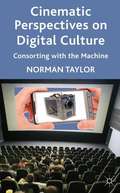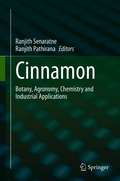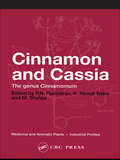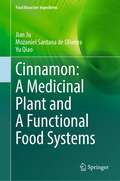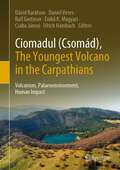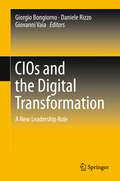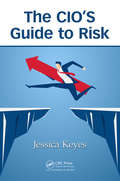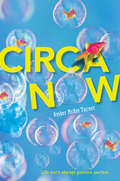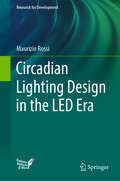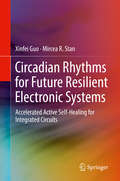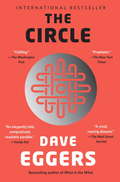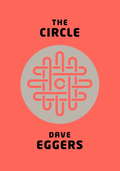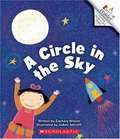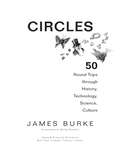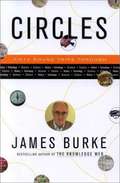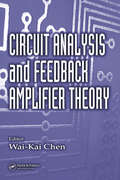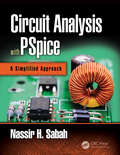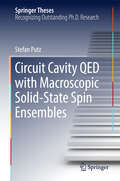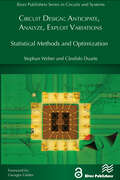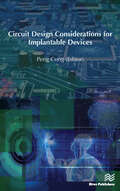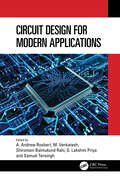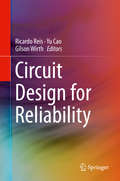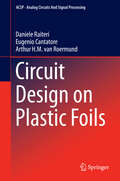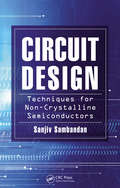- Table View
- List View
Cinematic Perspectives on Digital Culture
by Norman TaylorExploring research into mobile phone use as props to subjective identity, Norman Taylor employs concepts from Michelle Foucault, Gilles Deleuze and actor network theory to discuss the affect of mechanisms of make-believe, from celebrity culture to avatar-obsessed game players, and digital culture.
Cinnamon: Botany, Agronomy, Chemistry and Industrial Applications
by Ranjith Senaratne Ranjith PathiranaCinnamon is the common name for the spice obtained from the dried inner bark of several species of the genus Cinnamomum in the Lauraceae family. In world trade, Cinnamomum cassia (L.) J. Presl Cinnamomum burmannii dominate, but it is of a different quality to ‘true’ or ‘Ceylon’ cinnamon produced from Cinnamomum zeylanicum Blume (C. verum J. Presl), with the latter much easier to process, giving a more delicate, sweeter flavor with nuances of clove, but more importantly with only traces (often below detection thresholds) of coumarin, compared with 5–7 g/kg in other species. Cinnamon has been a popular and expensive spice in many civilizations, including ancient Egypt, Rome and in 14th and 15th century Europe, where it was used primarily to preserve meat for its antibacterial properties, fine aroma and flavor. Ancient Egyptians used cinnamon in mummification process due to its antibacterial properties and fragrance. The quest for cinnamon brought many explorers to Ceylon, whose ancient history is intertwined with the cinnamon trade. Ancient Egyptians and Romans used cinnamon as a valued spice and as an incense.In recent years, much research has been conducted in crop improvement, processing and value addition in cinnamon. In addition to direct use as a condiment/spice, cinnamon has found a multitude of uses in the food and beverage, traditional medicine, pharmacology, nutraceutical and cosmetics industries. Ceylon cinnamon is unique in that oils distilled from the bark (major constituents are cinnamaldehyde and oleoresins), leaf (eugenol is the major constituent used in dentistry, perfumes, flavorings and as an antioxidant) and roots (camphor) have different industrial uses. Cinnamaldehyde is now a proven natural bactericide widely used in food and beverage industry, effective against Salmonella spp. and Escherichia coli. Thus, it has become an important natural component of organic fruit and vegetable juices to enhance microbial safety of these nutritious beverages.Because of its manifold uses, cinnamon is an important crop. There have been many recent publications on its ethnobotany, genetics, crop improvement, agronomy, processing, biotechnology, chemistry, food and medicinal uses, and industrial applications. However, one book condensing all these findings is lacking. Our publication, with chapters devoted to all these aspects of cinnamon written by experts in these fields, condenses current knowledge into a single source and contribute to the advancement and dissemination of knowledge and technology. Contributors to the book constitute internationally renowned senior scientists and academics with hands-on experience as well as movers and shakers of industry, thereby striking a right balance between theory and practice. Therefore it is a valuable source for students, teachers, scientists, planners policy makers, practicing agriculturists and industrialists, and a prized acquisition to any library in higher education institutions, R & D institutions and public and private sector institutions in agriculture and allied fields.
Cinnamon and Cassia: The Genus Cinnamomum (Medicinal And Aromatic Plants S. - Industrial Profiles Ser.)
by P. N. Ravindran K. Nirmal Babu M. ShylajaCinnamon and Cassia, the "Spices of Life", together constitute one of the most widely used group of spices. A comprehensive volume, Cinnamon and Cassia: Genus Cinnamomum explores in detail Srilankan cinnamon, Chinese cassia, Indonesian cassia, Indian cassia, camphor, and also the important related and useful spices of Cinnamomum.The introdu
Cinnamon: A Medicinal Plant and A Functional Food Systems (Food Bioactive Ingredients)
by Jian Ju Mozaniel Santana de Oliveira Yu QiaoThis work addresses the multiple possibilities for using cinnamon for applications in food science technology and to help in the complimentary treatment and prevention of diseases, with priority given to secondary metabolites produced by this plant. Issues related to the functions of cinnamon and its applications, as well as the biosynthetic pathways of production by plants, are covered in depth. The link between food science and technology and specific medicinal plants has not been explored enough in the current literature, and this text looks to bridge this gap in its extensive coverage of cinnamon. CINNAMON: A Functional Food and Medicinal Plant provides readers with a broad and diverse overview of the importance of secondary metabolites produced by plants and the possibilities for innovative biotechnological approaches that introduce new potential to a wide range of industrial products. The application of cinnamon in products across food science and its numerous health benefits are outlined, including its use as a complimentary medicine for a number of diseases. This book features the main cinnamon varieties and production areas plus quality evaluation and bioactive compound extraction methods. The multiple applications of spices in foods are covered in depth, plus antioxidant activity and inhibitory effects on bacteria and fungi. Beyond its use in foods, readers will find chapters covering the antiviral effects of cinnamon and its use for the treatment and prevention of diabetes and other disorders. Also important is coverage on the safety aspects of cinnamon and its extracts. To date no book has exclusively covered the many uses of cinnamon and cinnamon extracts in food and pharmaceutical applications. This much-needed work provides a fully up to date and extensive overview for researchers to examine the many uses of cinnamon across multiple products and industries.
Ciomadul (Csomád), The Youngest Volcano in the Carpathians: Volcanism, Palaeoenvironment, Human Impact
by Dávid Karátson Daniel Veres Ralf Gertisser Enikő K. Magyari Csaba Jánosi Ulrich HambachThis book delivers the present state-of-the-art of scientific characteristics of the unique Ciomadul volcano (Romania, East-Central Europe) from as many aspects as possible.. Multidisciplinary research results obtained on this geologically young volcanic complex are presented to a wider audience (geologists, volcanologists, botanists, archaeologists, historians and teachers). Moreover, the book provides information at a general level for interested laypersons and decision-makers. The first part of the book, after summarizing the research history of Ciomadul, presents the details of the volcanism and related topics (volcanology, geology, landscape evolution, minerals, post-volcanic activity and spa culture) in eight chapters; the second part deals with the palaeo-environmental issues of the larger area, along with human history, in nine chapters.
CIOs and the Digital Transformation: A New Leadership Role
by Giorgio Bongiorno Daniele Rizzo Giovanni VaiaThis book describes how chief information officers (CIOs) can embrace and drive the digital transformation by providing innovative leadership that uses old skills in a novel way. The book explores ways in which new actors and factors will play a key role in this process and how new relations can be created among things, data, and people. In addition, the design of digital organizations and the implementation of digital technologies are carefully examined and it is explained how digital workspaces can be designed, organized, and used. A set of methods is provided for linking new digital tools in order to meet the goals and challenges of building a digital enterprise. The digital economy is disrupting the way of interaction within value chains, creating fresh spaces for competition and novel ecosystems. With the advent of social media networking, mobility, big data and cloud computing, 4. 0 manufacturing, etc. , we are witnessing the birth of new digital organizations. However, sharing of leadership of this change among different actors can create disorder and inefficiency. Against this background, the future role of the CIO will be crucial.
The CIO’s Guide to Risk
by Jessica KeyesIn an age of globalization, widely distributed systems, and rapidly advancing technological change, IT professionals and their managers must understand that risk is ever present. The key to project success is to identify risk and subsequently deal with it. The CIO’s Guide to Risk addresses the many faces of risk, whether it be in systems development, adoption of bleeding edge tech, the push for innovation, and even the march toward all things social media. Risk management planning, risk identification, qualitative and quantitative risk analysis, contingency planning, and risk monitoring and control are all addressed on a macro as well as micro level. The book begins with a big-picture view of analyzing technology trends to evaluate risk. It shows how to conceptualize trends, analyze their effect on infrastructure, develop metrics to measure success, and assess risk in adapting new technology. The book takes an in-depth look at project-related risks. It explains the fundamentals of project management and how project management relates to systems development and technology implementation. Techniques for analyzing project risk include brainstorming, the Delphi technique, assumption analysis, and decision analysis. Metrics to track and control project risks include the Balance Scorecard, project monitoring and reporting, and business and technology metrics. The book also takes an in-depth look at the role of knowledge management and innovation management in identifying, assessing, and managing risk. The book concludes with an executive’s guide to the legal and privacy issues related to risk management, as well overviews of risks associated with social media and mobile environments. With its checklists, templates, and worksheets, the book is an indispensable reference on risk and information technology.
Circa Now
by Amber McRee TurnerTwelve-year-old Circa Monroe has a knack for restoring old photographs. It's a skill she learned from her dad, who loves old pictures and putting fun digital twists on them. His altered "Shopt" photos look so real that they could fool nearly anybody, and Circa treasures the fun stories he makes up to explain each creation. One day, her father receives a strange phone call requesting an urgent delivery, and he heads out into a storm. The unimaginable happens: a tornado, then a terrible accident, and Circa never sees her dad again. Just as Circa and her mom begin to pick up the pieces, a mysterious boy shows up on their doorstep, a boy called Miles who remembers nothing about his past. The only thing he has with him is the photograph that Circa's dad intended to deliver on the day he died. As Circa tries to help Miles recover his identity, she begins to notice something strange about the photos she and her father retouched???the digital flourishes added to the old photos seem to exist in real life. The mysteries of the Shopt photos and Miles's past are intertwined, and in order to solve both, Circa will have to figure out what's real and what's an illusion. With stunning prose, captivating photographs, and a hint of magic, Circa Now is a gripping story full of hope and heart.
Circadian Lighting Design in the LED Era (Research for Development)
by Maurizio RossiThis book explores how lighting systems based on LED sources have the ability to positively influence the human circadian system, with benefits for health and well-being. The opening chapters examine the functioning of the human circadian system, its response to artificial lighting, potential health impacts of different types of light exposure, and current researches in circadian photometry. A first case study analyzes the natural lighting available in an urban interior, concluding that it is unable to activate the human circadian system over the entire year. Important original research is then described in which systems suitable for artificial circadian lighting in residential interiors and offices were developed after testing of new design paradigms based on LED sources. Readers will also find a detailed analysis of the LED products available or under development globally that may contribute to optimal artificial circadian lighting, as well as the environmental sensors, control interfaces, and monitoring systems suitable for integration with new LED lighting systems. Finally, guidelines for circadian lighting design are proposed, with identification of key requirements.
Circadian Rhythms for Future Resilient Electronic Systems: Accelerated Active Self-Healing for Integrated Circuits
by Xinfei Guo Mircea R. StanThis book describes methods to address wearout/aging degradations in electronic chips and systems, caused by several physical mechanisms at the device level. The authors introduce a novel technique called accelerated active self-healing, which fixes wearout issues by enabling accelerated recovery. Coverage includes recovery theory, experimental results, implementations and applications, across multiple nodes ranging from planar, FD-SOI to FinFET, based on both foundry provided models and predictive models. Presents novel techniques, tested with experiments on real hardware;Discusses circuit and system level wearout recovery implementations, many of these designs are portable and friendly to the standard design flow;Provides circuit-architecture-system infrastructures that enable the accelerated self-healing for future resilient systems;Discusses wearout issues at both transistor and interconnect level, providing solutions that apply to both;Includes coverage of resilient aspects of emerging applications such as IoT.
The Circle
by Dave EggersThe Circle is the exhilarating new novel from Dave Eggers, bestselling author of A Hologram for the King, a finalist for the National Book Award. <P>When Mae Holland is hired to work for the Circle, the world's most powerful internet company, she feels she's been given the opportunity of a lifetime. <P>The Circle, run out of a sprawling California campus, links users' personal emails, social media, banking, and purchasing with their universal operating system, resulting in one online identity and a new age of civility and transparency. <P>As Mae tours the open-plan office spaces, the towering glass dining facilities, the cozy dorms for those who spend nights at work, she is thrilled with the company's modernity and activity. <P>There are parties that last through the night, there are famous musicians playing on the lawn, there are athletic activities and clubs and brunches, and even an aquarium of rare fish retrieved from the Marianas Trench by the CEO. <P>Mae can't believe her luck, her great fortune to work for the most influential company in the world--even as life beyond the campus grows distant, even as a strange encounter with a colleague leaves her shaken, even as her role at the Circle becomes increasingly public. <P>What begins as the captivating story of one woman's ambition and idealism soon becomes a heart-racing novel of suspense, raising questions about memory, history, privacy, democracy, and the limits of human knowledge.
The Circle
by Dave EggersThe Circle is the exhilarating new novel from Dave Eggers, bestselling author of A Hologram for the King, a finalist for the National Book Award. When Mae Holland is hired to work for the Circle, the world's most powerful internet company, she feels she's been given the opportunity of a lifetime. The Circle, run out of a sprawling California campus, links users' personal emails, social media, banking, and purchasing with their universal operating system, resulting in one online identity and a new age of civility and transparency. As Mae tours the open-plan office spaces, the towering glass dining facilities, the cozy dorms for those who spend nights at work, she is thrilled with the company's modernity and activity. There are parties that last through the night, there are famous musicians playing on the lawn, there are athletic activities and clubs and brunches, and even an aquarium of rare fish retrieved from the Marianas Trench by the CEO. Mae can't believe her luck, her great fortune to work for the most influential company in the world--even as life beyond the campus grows distant, even as a strange encounter with a colleague leaves her shaken, even as her role at the Circle becomes increasingly public. What begins as the captivating story of one woman's ambition and idealism soon becomes a heart-racing novel of suspense, raising questions about memory, history, privacy, democracy, and the limits of human knowledge.From the Hardcover edition.
The Circle (A Dan Lenson Novel #3)
by David PoyerA novel of duty, betrayal, and adventure in the world's most dangerous seas (the Arctic), by the bestselling author of The Med and The Gulf.
A Circle in the Sky
by Zachary WilsonA child puts together various simple shapes to build a rocket that will fly to the moon.
Circles: Fifty Round Trips Through History Technology Science Culture
by James BurkeFrom the bestselling author of The Knowledge Web come fifty mesmerizing journeys into the history of technology, each following a chain of consequential events that ends precisely where it began. Whether exploring electromagnetic fields, the origin of hot chocolate, or DNA fingerprinting, these essays -- which originally appeared in James Burke's popular Scientific American column -- all illustrate the serendipitous and surprisingly circular nature of change. In "Room with (Half) a View," for instance, Burke muses about the partly obscured railway bridge outside his home on the Thames. Thinking of the bridge engineer, who also built the steamship that laid the first transatlantic telegraph cable, causes him to recall Samuel Morse; which, in turn, conjures up Morse's neighbor, firearms inventor Sam Colt, and his rival, Remington. One dizzying connection after another leads to Karl Marx's daughter, who attended Socialist meetings with a trombonist named Gustav Holst, who once lived in the very house that blocks Burke's view of the bridge on the Thames. Burke's essays all evolve in this organic manner, highlighting the interconnectedness of seemingly unrelated events and innovations. Romantic poetry leads to brandy distillation; tonic water connects through Leibniz to the first explorers to reach the North Pole. Witty, instructive, and endlessly entertaining, Circles expands on the trademark style that has captivated James Burke fans for years. This unique collection is sure to stimulate and delight history buffs, technophiles, and anyone else with a healthy intellectual curiosity.
Circles: 50 Round Trips through History, Technology, Science, Culture
by James Lee BurkeFrom the bestselling author of "The Knowledge Web" come fifty mesmerizing journeys into the history of technology, each following a chain of consequential events that ends precisely where it began. Whether exploring electromagnetic fields, the origin of hot chocolate, or DNA fingerprinting, these essays -- which originally appeared in James Burke's popular "Scientific American" column -- all illustrate the serendipitous and surprisingly circular nature of change. In "Room with (Half) a View," for instance, Burke muses about the partly obscured railway bridge outside his home on the Thames. Thinking of the bridge engineer, who also built the steamship that laid the first transatlantic telegraph cable, causes him to recall Samuel Morse; which, in turn, conjures up Morse's neighbor, firearms inventor Sam Colt, and his rival, Remington. One dizzying connection after another leads to Karl Marx's daughter, who attended Socialist meetings with a trombonist named Gustav Holst, who once lived in the very house that blocks Burke's view of the bridge on the Thames. Burke's essays all evolve in this organic manner, highlighting the interconnectedness of seemingly unrelated events and innovations. Romantic poetry leads to brandy distillation; tonic water connects through Leibniz to the first explorers to reach the North Pole. Witty, instructive, and endlessly entertaining, Circles expands on the trademark style that has captivated James Burke fans for years. This unique collection is sure to stimulate and delight history buffs, technophiles, and anyone else with a healthy intellectual curiosity.
Circuit Analysis and Feedback Amplifier Theory
by Wai-Kai ChenCulled from the pages of CRC's highly successful, best-selling The Circuits and Filters Handbook, Second Edition, Circuit Analysis and Feedback Amplifier Theory presents a sharply focused, comprehensive review of the fundamental theory behind professional applications of circuits and feedback amplifiers. It supplies a concise, convenient reference to the key concepts, models, and equations necessary to analyze, design, and predict the behavior of large-scale circuits and feedback amplifiers, illustrated by frequent examples. Edited by a distinguished authority, this book emphasizes the theoretical concepts underlying the processes, behavior, and operation of these devices. It includes guidance on the design of multiple-loop feedback amplifiers. More than 350 figures and tables illustrate the concepts, and where necessary, the theories, principles, and mathematics of some subjects are reviewed. Expert contributors discuss analysis in the time and frequency domains, symbolic analysis, state-variable techniques, feedback amplifier configurations, general feedback theory, and network functions and feedback, among many other topics.Circuit Analysis and Feedback Amplifier Theory builds a strong theoretical foundation for the design and analysis of advanced circuits and feedback amplifiers while serving as a handy reference for experienced engineers, making it a must-have for both beginners and seasoned experts.
Circuit Analysis with PSpice: A Simplified Approach
by Nassir H. SabahElectric circuits, and their electronic circuit extensions, are found in all electrical and electronic equipment; including: household equipment, lighting, heating, air conditioning, control systems in both homes and commercial buildings, computers, consumer electronics, and means of transportation, such as cars, buses, trains, ships, and airplanes. Electric circuit analysis is essential for designing all these systems. Electric circuit analysis is a foundation for all hardware courses taken by students in electrical engineering and allied fields, such as electronics, computer hardware, communications and control systems, and electric power. This book is intended to help students master basic electric circuit analysis, as an essential component of their professional education. Furthermore, the objective of this book is to approach circuit analysis by developing a sound understanding of fundamentals and a problem-solving methodology that encourages critical thinking.
Circuit Cavity QED with Macroscopic Solid-State Spin Ensembles (Springer Theses)
by Stefan PutzThis thesis combines quantum electrical engineering with electron spin resonance, with an emphasis on unraveling emerging collective spin phenomena. The presented experiments, with first demonstrations of the cavity protection effect, spectral hole burning and bistability in microwave photonics, cover new ground in the field of hybrid quantum systems. The thesis starts at a basic level, explaining the nature of collective effects in great detail. It develops the concept of Dicke states spin-by-spin, and introduces it to circuit quantum electrodynamics (QED), applying it to a strongly coupled hybrid quantum system studied in a broad regime of several different scenarios. It also provides experimental demonstrations including strong coupling, Rabi oscillations, nonlinear dynamics, the cavity protection effect, spectral hole burning, amplitude bistability and spin echo spectroscopy.
Circuit Design: Anticipate, Analyze, Exploit Variations
by Stephan Weber Candido DuarteCircuit Design = Science + Art! Designers need a skilled "gut feeling" about circuits and related analytical techniques, plus creativity, to solve all problems and to adhere to the specifications, the written and the unwritten ones. You must anticipate a large number of influences, like temperature effects, supply voltages changes, offset voltages, layout parasitics, and numerous kinds of technology variations to end up with a circuit that works. This is challenging for analog, custom-digital, mixed-signal or RF circuits, and often researching new design methods in relevant journals, conference proceedings and design tools unfortunately gives the impression that just a "wild bunch" of "advanced techniques" exist. On the other hand, state-of-the-art tools nowadays indeed offer a good cockpit to steer the design flow, which include clever statistical methods and optimization techniques.Actually, this almost presents a second breakthrough, like the introduction of circuit simulators 40 years ago! Users can now conveniently analyse all the problems (discover, quantify, verify), and even exploit them, for example for optimization purposes. Most designers are caught up on everyday problems, so we fit that "wild bunch" into a systematic approach for variation-aware design, a designer's field guide and more. That is where this book can help! Circuit Design: Anticipate, Analyze, Exploit Variations starts with best-practise manual methods and links them tightly to up-to-date automation algorithms. We provide many tractable examples and explain key techniques you have to know. We then enable you to select and setup suitable methods for each design task - knowing their prerequisites, advantages and, as too often overlooked, their limitations as well. The good thing with computers is that you yourself can often verify amazing things with little effort, and you can use software not only to your direct advantage in solving a specific problem, but also for becoming a better skilled, more experienced engineer. Unfortunately, EDA design environments are not good at all to learn about advanced numerics. So with this book we also provide two apps for learning about statistic and optimization directly with circuit-related examples, and in real-time so without the long simulation times. This helps to develop a healthy statistical gut feeling for circuit design. The book is written for engineers, students in engineering and CAD / methodology experts. Readers should have some background in standard design techniques like entering a design in a schematic capture and simulating it, and also know about major technology aspects.
Circuit Design Considerations for Implantable Devices
by Peng CongImplantable devices are a unique area for circuit designers. A comprehensive understanding of design trade-offs at the system level is important to ensure device success. Circuit Design Considerations for Implantable Devices provides knowledge to CMOS circuit designers with limited biomedical background to understand design challenges and trade-offs for implantable devices, especially neural interfacing.Technical topics discussed in the book include: Neural interface Neural sensing amplifiers Electrical stimulation Embedded Signal Analysis Wireless Power Transmission to mm-Sized Free-Floating Distributed Implants Next Generation Neural Interface Electronics
Circuit Design for Modern Applications
by A. Andrew Roobert, M. Venkatesh, Shiromani Balmukund Rahi, G. Lakshmi Priya and Samuel TensinghThis book offers a clear exploration of cutting-edge semiconductor circuit technologies and their practical applications. It covers topics like advanced transistor design, low-power consumption techniques, and high-performance circuit design.Circuit Design for Modern Applications explores the recent innovations in semiconductor technology. Bandgap reference circuits, quad model transistors, voltagecontrolled oscillators, LDO regulators, power amplifiers, low noise amplifiers, operational amplifiers, low-power CNTFET-based quaternary multipliers, and STT MRAM-based cache memory for multicore systems are discussed. It points out the difficulties in designing CMOS analog and RF circuits for mmWave applications and looks into newly developed field-effect transistors for an alternate solution. Innovative devices such as III-V material-based HEMTs, and junctionless FETs are discussed. The book also looks at creative ways to improve circuit performance and energy efficiency, which is a useful resource for academics, researchers, and industry experts working in semiconductors.This book will help the readers to stay on the cutting edge of contemporary circuit design technologies, covering various topics from fundamental circuit design to high-performance circuits.
Circuit Design for Reliability
by Yu Cao Gilson Wirth Ricardo ReisThis book presents physical understanding, modeling and simulation, on-chip characterization, layout solutions, and design techniques that are effective to enhance the reliability of various circuit units. The authors provide readers with techniques for state of the art and future technologies, ranging from technology modeling, fault detection and analysis, circuit hardening, and reliability management.
Circuit Design on Plastic Foils (Analog Circuits and Signal Processing #133)
by Eugenio Cantatore Arthur H.M. Roermund Daniele RaiteriThis book illustrates a variety of circuit designs on plastic foils and provides all the information needed to undertake successful designs in large-area electronics. The authors demonstrate architectural, circuit, layout, and device solutions and explain the reasons and the creative process behind each. Readers will learn how to keep under control large-area technologies and achieve robust, reliable circuit designs that can face the challenges imposed by low-cost low-temperature high-throughput manufacturing.
Circuit Design Techniques for Non-Crystalline Semiconductors
by Sanjiv SambandanDespite significant progress in materials and fabrication technologies related to non-crystalline semiconductors, fundamental drawbacks continue to limit real-world application of these devices in electronic circuits. To help readers deal with problems such as low mobility and intrinsic time variant behavior, Circuit Design Techniques for Non-Cryst
